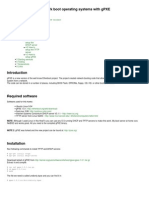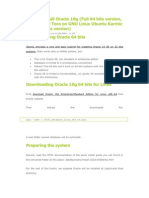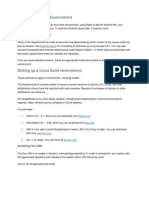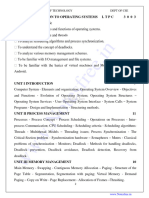Rtems Installation Procedure
Uploaded by
Constantine GiotopoulosRtems Installation Procedure
Uploaded by
Constantine GiotopoulosESA UNCLASSIFIED Releasable to the Public
estec
European Space Research and Technology Centre Keplerlaan 1 2201 AZ Noordwijk The Netherlands T +31 (0)71 565 6565 F +31 (0)71 565 6040 www.esa.int
Date From To
25/11/2010 Julien Delange
Ref Visa Copy
Subject: Installation of RTEMS 4.8 serie and QEMU under Ubuntu
DESCRIPTION
This document provides information for the installation of RTEMS 4.8 with the PC386 BSP and QEMU under Ubuntu Linux. This will allow the user to execute RTEMS applications on top of QEMU.
INSTALLATION PROCEDURE DOCUMENTATION
The reference documentation can be found on the RTEMS official website. For the 4.8 release serie, the link is the following: http://rtems.com/onlinedocs/releases/rtemsdocs-4.8.0
VIRTUAL MACHINE INSTALLATION
The tools can also be used within a virtual machine provided with this document. This virtual machine is a VMWare image that can be run with VMWare Player. The user account is rtems, password is rtems.
INSTALLED COMPONENTS, VERSIONS AND CONFIGURATION
Page 1/6
ESA UNCLASSIFIED Releasable to the Public
4.1
Components and versions
Ubuntu: 10.10 (maverick) QEMU: 0.12.5 RTEMS: 4.8.2 GCC: 4.2.4 GDB: 6.8 Newlib: 1.15 Binutils: 2.18
4.2 Configuration
Target: i386-rtems RTEMS BSP: pc386
5 5.1
INSTALLATION PROCEDURE Install dependencies
Issue the following command:
apt-get install qemu cvs patch texinfo libc6-dev gcc4.3 gcc-4.1 libgmp3-dev libmpfr-dev automake autoconf
5.2
5.2.1
Download software packages
Binutils
cd build && wget http://ftp.gnu.org/gnu/binutils/binutils-2.18.tar.gz
5.2.2
GDB
cd build && wget http://ftp.gnu.org/gnu/gdb/gdb6.8.tar.gz
Page 2/6 Date 25/11/2010 Ref
ESA UNCLASSIFIED Releasable to the Public
5.2.3
GCC
cd build && wget http://ftp.gnu.org/gnu/gcc/gcc-4.2.4/gcccore-4.2.4.tar.bz2
5.2.4
NEWLIB
cd build && wget ftp://sources.redhat.com/pub/newlib/newlib-1.15.0.tar.gz
5.2.5
Mirrors
If you encounter some issues while downloading the sources, copies are available at http://rtems.com/ftp/pub/rtems/SOURCES
5.3
Download RTEMS from the CVS server
cd build && cvs -d :pserver:anoncvs@www.rtems.com:/usr1/CVS -z 9 co -rrtems-4-8-branch rtems
5.4 Download RTEMS from FTP server
5.4.1 Download RTEMS release
The RTEMS release can be found at http://rtems.com/ftp. You can download it using the following command. cd build && http://www.rtems.com/ftp/pub/rtems/4.8.2/rtems4.8.2.tar.bz2
5.4.2
Download patches
Patches can be found using a web browser at http://www.rtems.com/cvsweb They are contained in the directory rtems/contrib/crossrpms/patches directory for the 4-8-branch of RTEMS.
5.5
Unpack cross-compiler archives
cd build && tar zxvf binutils-2.18.tar.gz tar zxvf gdb-6.8.tar.gz
Page 3/6 Date 25/11/2010 Ref
ESA UNCLASSIFIED Releasable to the Public
tar jxvf gcc-core-4.2.4.tar.bz2 tar zxvf newlib-1.15.0.tar.gz
5.6
Apply patches
We assume that patches are contained in the /home/rtems/build/patches directory. They can be found on the CVS repository, in the directory rtems/contrib/crossrpms/patches for the branch 4-8-branch.
5.6.1
Binutils
cd binutils-2.18 && patch p1 < ../patches/binutils2.18-rtems4.8-20071104.diff
5.6.2
GCC
cd gcc-4.2.4 && patch p1 < ../patches/gcc-core-4.2.4rtems4.8-20080526.diff
5.6.3
Newlib
cd newlib && patch p1 < ../patches/newlib-1.15.0rtems4.8-20080903.diff
5.6.4
GDB
cd gdb-6.8 && patch p1 < ../patches/gdb-6.8-rtems4.820080429.diff
5.7
5.7.1
Configure and build the toolchain
Configure and build binutils
cd build && mkdir b-binutils && cd b-binutils && CC=gcc-4.1 ../binutils-2.18/configure target=i386rtems4.8 prefix=/home/rtems/local
5.7.2
Configure and build GCC
cd build && cd gcc-4.2.4 && ln s ../newlib1.15.0/newlib . && cd .. && mkdir b-gcc && cd b-gcc && PATH=/home/rtems/local/bin:$PATH ../gcc-4.2.4/configure target=i386-rtems4.8 prefix=/home/rtems/local withgnu-as with-gnu-ld with-newlib verbose enablethreads enable-languages=c
Page 4/6 Date 25/11/2010 Ref
ESA UNCLASSIFIED Releasable to the Public
5.7.3
Configure and build GDB
cd build && mkdir b-gdb && cd b-gdb && PATH=/home/rtems/local/bin:$PATH ../gdb-6.8/configure target=i386-rtems4.8 prefix=/home/rtems/local
5.8 Configure and build RTEMS
If you download RTEMS from the CVS repository, you may need to generate the configure script with the autotools. In that case, invoke the following command cd build && cd rtems-4.8.2 && ./bootstrap Then, invoke the configure script and the compiler chain: cd build && mkdir b-rtems && cd b-rtems && PATH=/home/rtems/local/bin:$PATH ../rtems4.8.2/configure target=i386-rtems4.8 enable-posix enable-networking prefix=/home/rtems/local/packages/rtems4.8 enabletests && PATH=/home/rtems/local/bin:$PATH make all install RTEMS_BSP=pc386
RUN RTEMS TESTS
At first, you have to set the RTEMS_MAKEFILE_PATH variable to the directory that corresponds to your RTEMS BSP. You can do that with the following command line:
set RTEMS_MAKEFILE_PATH=/home/rtems/local/packages/rtems4.8 /i386-rtems4.8/pc386/
Then, download the testsuite on http://www.rtems.com/ftp/pub/rtems/4.8.2/examples-4.8.2.tar.bz2 and unpack the archive.
cd && mkdir examples && cd examples && wget http://www.rtems.com/ftp/pub/rtems/4.8.2/examples-4.8.2.tar.bz2 && tar jxvf examples-4.8.2.tar.bz2 Then, build and run the hello_world_c example
Page 5/6 Date 25/11/2010 Ref
ESA UNCLASSIFIED Releasable to the Public
cd && cd examples/examples-4.8/hello_world_c/ && make && cd o-optimize && qemu fda /home/rtems/rtemsboot.img hda fat:. boot a Then, once in QEMU, type the following lines in grub set root=(hd0,0) multiboot (hd0,0)/hello.exe boot
When you build the example, it creates the binary in the o-optimize directory. Then, to run it with QEMU, you need a bootloader. This is provided by the rtemsboot.img image file (available at http://www.rtems.com/ftp/pub/rtems/qemu/i386-pc/ ). Then, when you start GRUB, you need to tell it to use this file as a boot image. This is done with the fda option (which indicates the image for a floppy disk) and the boot a option (that indicates you boot on the floppy disk). Then, the had fat:. option is used to specify that the current directory is used as an harddrive. Once you are in grub, you have to tell grub that the root device is the harddrive. This is done with the set root=(hd0,0) command. Finally, you need to load the binary, indicating its location on the system. Here, the binary is on the harddrive considered by GRUB, so, (hd0,0). You load RTEMS application with the multiboot command, so, you use the following command to launch the hello.exe binary: multiboot (hd0,0)/hello.exe . Finally, you start the system using the command boot.
Page 6/6 Date 25/11/2010 Ref
You might also like
- Hourglass Workout Program by Luisagiuliet 276% (21)Hourglass Workout Program by Luisagiuliet 251 pages
- The Hold Me Tight Workbook - Dr. Sue Johnson100% (16)The Hold Me Tight Workbook - Dr. Sue Johnson187 pages
- Read People Like A Book by Patrick King-Edited62% (66)Read People Like A Book by Patrick King-Edited12 pages
- Livingood, Blake - Livingood Daily Your 21-Day Guide To Experience Real Health77% (13)Livingood, Blake - Livingood Daily Your 21-Day Guide To Experience Real Health260 pages
- COSMIC CONSCIOUSNESS OF HUMANITY - PROBLEMS OF NEW COSMOGONY (V.P.Kaznacheev,. Л. V. Trofimov.)94% (212)COSMIC CONSCIOUSNESS OF HUMANITY - PROBLEMS OF NEW COSMOGONY (V.P.Kaznacheev,. Л. V. Trofimov.)212 pages
- Donald Trump & Jeffrey Epstein Rape Lawsuit and Affidavits83% (1016)Donald Trump & Jeffrey Epstein Rape Lawsuit and Affidavits13 pages
- The 36 Questions That Lead To Love - The New York Times94% (34)The 36 Questions That Lead To Love - The New York Times3 pages
- The 36 Questions That Lead To Love - The New York Times95% (21)The 36 Questions That Lead To Love - The New York Times3 pages
- Jeffrey Epstein39s Little Black Book Unredacted PDF75% (12)Jeffrey Epstein39s Little Black Book Unredacted PDF95 pages
- The 4 Hour Workweek, Expanded and Updated by Timothy Ferriss - Excerpt23% (954)The 4 Hour Workweek, Expanded and Updated by Timothy Ferriss - Excerpt38 pages
- How To Build Your Own Image For Raspberry PI 4 - Home Connected Device Innovation - Confluence For OrangeNo ratings yetHow To Build Your Own Image For Raspberry PI 4 - Home Connected Device Innovation - Confluence For Orange6 pages
- Installation OpenMeetings 3.0.x On Ubuntu 14.04 PDFNo ratings yetInstallation OpenMeetings 3.0.x On Ubuntu 14.04 PDF17 pages
- Network Boot Operating Systems With gPXENo ratings yetNetwork Boot Operating Systems With gPXE5 pages
- Linux Driver - Binary Rpm/source RPM User Guide and Known Limitation0% (1)Linux Driver - Binary Rpm/source RPM User Guide and Known Limitation11 pages
- Instal An Do Headers e Essential para Acesso VboxNo ratings yetInstal An Do Headers e Essential para Acesso Vbox6 pages
- Installation - GR-GSM - Open Source Mobile CommunicationsNo ratings yetInstallation - GR-GSM - Open Source Mobile Communications5 pages
- How To Install Gtsnets ? A Setp-By-Step Installation TutorialNo ratings yetHow To Install Gtsnets ? A Setp-By-Step Installation Tutorial12 pages
- Installation OpenMeetings 4.0.0 On Ubuntu 16.04 LTSNo ratings yetInstallation OpenMeetings 4.0.0 On Ubuntu 16.04 LTS16 pages
- Kubernetes Cluster Creation Using KubeadmNo ratings yetKubernetes Cluster Creation Using Kubeadm6 pages
- All in One OpenAirInterface - 4G and 5G Reference SoftwareNo ratings yetAll in One OpenAirInterface - 4G and 5G Reference Software408 pages
- Instalar Oracle 10g en Ubuntu La EfectivaNo ratings yetInstalar Oracle 10g en Ubuntu La Efectiva11 pages
- Installation OpenMeetings - On - CentOsNo ratings yetInstallation OpenMeetings - On - CentOs17 pages
- Installation: Cooperative Mobile Systems (CMS)No ratings yetInstallation: Cooperative Mobile Systems (CMS)7 pages
- Installation of Lammps-9dec14 On Mac OS X YosemiteNo ratings yetInstallation of Lammps-9dec14 On Mac OS X Yosemite4 pages
- Fedora / Redhat / Centos7 / Centos8 - Compiling The Latest Kernel - Updated 2020-01No ratings yetFedora / Redhat / Centos7 / Centos8 - Compiling The Latest Kernel - Updated 2020-0119 pages
- Train Neural Networks Using AMD GPU and Keras - by Mattia Varile - Towards Data ScienceNo ratings yetTrain Neural Networks Using AMD GPU and Keras - by Mattia Varile - Towards Data Science19 pages
- Gnuradio Installation Notes: Version Modified/Creation Date DescriptionNo ratings yetGnuradio Installation Notes: Version Modified/Creation Date Description15 pages
- EDB Postgres Enterprise Edition V 13 Installation and Upgrade GuideNo ratings yetEDB Postgres Enterprise Edition V 13 Installation and Upgrade Guide27 pages
- Install OMV On Iomega HMNHD Cloud Edition With Disk Image - v05No ratings yetInstall OMV On Iomega HMNHD Cloud Edition With Disk Image - v054 pages
- Evaluation of Some Windows and Linux Intrusion Detection ToolsFrom EverandEvaluation of Some Windows and Linux Intrusion Detection ToolsNo ratings yet
- Evaluation of Some Intrusion Detection and Vulnerability Assessment ToolsFrom EverandEvaluation of Some Intrusion Detection and Vulnerability Assessment ToolsNo ratings yet
- Linux - a Secure Personal Computer for Beginners. Second Edition.From EverandLinux - a Secure Personal Computer for Beginners. Second Edition.No ratings yet
- Configuration of a Simple Samba File Server, Quota and Schedule BackupFrom EverandConfiguration of a Simple Samba File Server, Quota and Schedule BackupNo ratings yet
- Navigator DT XPIC Radio Configuration - RLA Mode - V3No ratings yetNavigator DT XPIC Radio Configuration - RLA Mode - V315 pages
- How To Use and Troubleshoot The Inspiron 3521 Dell USNo ratings yetHow To Use and Troubleshoot The Inspiron 3521 Dell US6 pages
- Hardware Certification Step by Step GuideNo ratings yetHardware Certification Step by Step Guide27 pages
- Amlogic Bootup and Nand EMMC Partition Config Guide v0.1 PDFNo ratings yetAmlogic Bootup and Nand EMMC Partition Config Guide v0.1 PDF10 pages
- Mitsubishi: Notification of The MELSEC-Q Series PLC CPU Upgrade (Q02CPU, Q02HCPU, Q06HCPU, Q12HCPU, Q25HCPU)0% (1)Mitsubishi: Notification of The MELSEC-Q Series PLC CPU Upgrade (Q02CPU, Q02HCPU, Q06HCPU, Q12HCPU, Q25HCPU)8 pages
- How To Create A Bootable Installer For MacOS - Apple SupportNo ratings yetHow To Create A Bootable Installer For MacOS - Apple Support3 pages
- MatriVideo Software Evaluation Quick Start GuideNo ratings yetMatriVideo Software Evaluation Quick Start Guide12 pages
- Mod F1 - V3.8.0 Install Instructions - J69183 - EN - 2023-02-08No ratings yetMod F1 - V3.8.0 Install Instructions - J69183 - EN - 2023-02-0812 pages
- Packet Tracer - Configure Initial Router Settings: ObjectivesNo ratings yetPacket Tracer - Configure Initial Router Settings: Objectives4 pages
- User Manual - H.264 DVR - 20100301 - (5479KB)No ratings yetUser Manual - H.264 DVR - 20100301 - (5479KB)65 pages
- Upgrading IOS-XE 3.X To IOS-XE Denali 16.X - Write MemNo ratings yetUpgrading IOS-XE 3.X To IOS-XE Denali 16.X - Write Mem5 pages
- Livingood, Blake - Livingood Daily Your 21-Day Guide To Experience Real HealthLivingood, Blake - Livingood Daily Your 21-Day Guide To Experience Real Health
- COSMIC CONSCIOUSNESS OF HUMANITY - PROBLEMS OF NEW COSMOGONY (V.P.Kaznacheev,. Л. V. Trofimov.)COSMIC CONSCIOUSNESS OF HUMANITY - PROBLEMS OF NEW COSMOGONY (V.P.Kaznacheev,. Л. V. Trofimov.)
- Donald Trump & Jeffrey Epstein Rape Lawsuit and AffidavitsDonald Trump & Jeffrey Epstein Rape Lawsuit and Affidavits
- The 36 Questions That Lead To Love - The New York TimesThe 36 Questions That Lead To Love - The New York Times
- The 36 Questions That Lead To Love - The New York TimesThe 36 Questions That Lead To Love - The New York Times
- Jeffrey Epstein39s Little Black Book Unredacted PDFJeffrey Epstein39s Little Black Book Unredacted PDF
- The 4 Hour Workweek, Expanded and Updated by Timothy Ferriss - ExcerptThe 4 Hour Workweek, Expanded and Updated by Timothy Ferriss - Excerpt
- How To Build Your Own Image For Raspberry PI 4 - Home Connected Device Innovation - Confluence For OrangeHow To Build Your Own Image For Raspberry PI 4 - Home Connected Device Innovation - Confluence For Orange
- Installation OpenMeetings 3.0.x On Ubuntu 14.04 PDFInstallation OpenMeetings 3.0.x On Ubuntu 14.04 PDF
- Linux Driver - Binary Rpm/source RPM User Guide and Known LimitationLinux Driver - Binary Rpm/source RPM User Guide and Known Limitation
- Installation - GR-GSM - Open Source Mobile CommunicationsInstallation - GR-GSM - Open Source Mobile Communications
- How To Install Gtsnets ? A Setp-By-Step Installation TutorialHow To Install Gtsnets ? A Setp-By-Step Installation Tutorial
- Installation OpenMeetings 4.0.0 On Ubuntu 16.04 LTSInstallation OpenMeetings 4.0.0 On Ubuntu 16.04 LTS
- All in One OpenAirInterface - 4G and 5G Reference SoftwareAll in One OpenAirInterface - 4G and 5G Reference Software
- Installation of Lammps-9dec14 On Mac OS X YosemiteInstallation of Lammps-9dec14 On Mac OS X Yosemite
- Fedora / Redhat / Centos7 / Centos8 - Compiling The Latest Kernel - Updated 2020-01Fedora / Redhat / Centos7 / Centos8 - Compiling The Latest Kernel - Updated 2020-01
- Train Neural Networks Using AMD GPU and Keras - by Mattia Varile - Towards Data ScienceTrain Neural Networks Using AMD GPU and Keras - by Mattia Varile - Towards Data Science
- Gnuradio Installation Notes: Version Modified/Creation Date DescriptionGnuradio Installation Notes: Version Modified/Creation Date Description
- EDB Postgres Enterprise Edition V 13 Installation and Upgrade GuideEDB Postgres Enterprise Edition V 13 Installation and Upgrade Guide
- Install OMV On Iomega HMNHD Cloud Edition With Disk Image - v05Install OMV On Iomega HMNHD Cloud Edition With Disk Image - v05
- Evaluation of Some Windows and Linux Intrusion Detection ToolsFrom EverandEvaluation of Some Windows and Linux Intrusion Detection Tools
- Evaluation of Some Intrusion Detection and Vulnerability Assessment ToolsFrom EverandEvaluation of Some Intrusion Detection and Vulnerability Assessment Tools
- Linux - a Secure Personal Computer for Beginners. Second Edition.From EverandLinux - a Secure Personal Computer for Beginners. Second Edition.
- Configuration of a Simple Samba File Server, Quota and Schedule BackupFrom EverandConfiguration of a Simple Samba File Server, Quota and Schedule Backup
- Navigator DT XPIC Radio Configuration - RLA Mode - V3Navigator DT XPIC Radio Configuration - RLA Mode - V3
- How To Use and Troubleshoot The Inspiron 3521 Dell USHow To Use and Troubleshoot The Inspiron 3521 Dell US
- Amlogic Bootup and Nand EMMC Partition Config Guide v0.1 PDFAmlogic Bootup and Nand EMMC Partition Config Guide v0.1 PDF
- Mitsubishi: Notification of The MELSEC-Q Series PLC CPU Upgrade (Q02CPU, Q02HCPU, Q06HCPU, Q12HCPU, Q25HCPU)Mitsubishi: Notification of The MELSEC-Q Series PLC CPU Upgrade (Q02CPU, Q02HCPU, Q06HCPU, Q12HCPU, Q25HCPU)
- How To Create A Bootable Installer For MacOS - Apple SupportHow To Create A Bootable Installer For MacOS - Apple Support
- Mod F1 - V3.8.0 Install Instructions - J69183 - EN - 2023-02-08Mod F1 - V3.8.0 Install Instructions - J69183 - EN - 2023-02-08
- Packet Tracer - Configure Initial Router Settings: ObjectivesPacket Tracer - Configure Initial Router Settings: Objectives
- Upgrading IOS-XE 3.X To IOS-XE Denali 16.X - Write MemUpgrading IOS-XE 3.X To IOS-XE Denali 16.X - Write Mem























































































































